
We already heard Apple secured the lion’s share of chipmaker TSMC’s 3nm chip manufacturing capacity. The latest rumor suggests the order has expanded to claim TSMC’s entire supply for the next 12 months.
According to a report from the Economic Daily News, Apple’s processor orders will occupy the full capacity of TSMC’s 3nm manufacturing capabilities. That is a significant win for the Mac and iPhone maker since TSMC’s 3nm node is more advanced than Samsung’s.
Apple’s next-generation Mac computers should feature high-performance, yet efficient M3 processors based on N3 (3nm node). The iPhone 15 Pro and Pro Max will boast A17 Bionic chips of this type as well.
Every reduction in manufacturing size brings performance gains while using less power. The difference will be most noticeable for new Mac computers since the M2-series chips use TSMC’s N5P (performance-enhanced 5nm node) design. The iPhone 14 Pro featured a TSMC N4 design, the A16 Bionic.
TSMC’s 3nm chip design will be faster and more efficient than any other consumer technology. Apple will be the first to use these processors in products launching later this year. If the rumor is correct, Apple could also have exclusive access for the next 12 months.
This report might help allay fears that Apple could face chip shortages in 2024. The tech giant has such a robust supply chain that it sustained high production levels through most of the pandemic chip shortages.
Given the potential for significant speed gains and extended battery life, Apple’s fall event should be more interesting than ever, with powerful new Macs and iPhones. A new iMac, 13-inch MacBook Air, and 13-inch MacBook Pro are expected.
This allocation could come with price increases, though. As analyst Ming-Chi Kuo points out, Apple will be purchasing TSMC’s latest finished node. The company, according to the analyst, loops the price of defective chips into the cost of finished wafers, causing the price of new processors to steadily go up. The analyst predicts this year’s A17 (and likely the M3) will continue this trend.
Editors’ Recommendations

